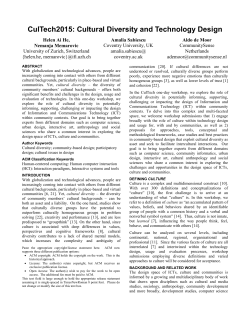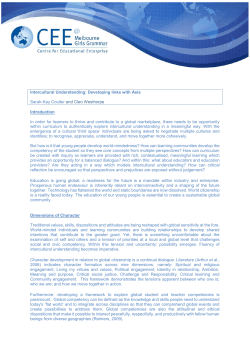
Cultural Competencies - Extension
CULTURAL COMPETENCIES FOR OUTREACH PROFESSIONALS KEY DEFINITIONS: Diversity: Differences are expressed in many ways including race, sex, age, physical and mental ability, sexual orientation, religion, class, philosophy and culture. (WSU Strategic Plan – 2008) Culture: A socially transmitted worldview learned and shared by a group which influences values, beliefs, customs and behaviors and which is reflected in their language, material culture, food, and social institutions. (Andrews & Boyle, 1999; Axelson, 1993; Burchum, 2002; Leininger, 1991, 1995; Mead, 1955; Pauwels, 1995; Purnell & Paulanka, 1998; Salmond, 2000; Schriver, 1995). Cultural competence: “A set of congruent behaviors, attitudes, and policies that come together in a system, agency, or among professionals that enables effective work in cross-cultural situations. Competence, in particular, implies having the capacity to function effectively as an individual and an organization within the context of the cultural beliefs, behaviors, and needs presented by [participants] in their communities.” (Adapted from Cross, Bazron, Dennis, & Isaacs, 1989). Culturally competent programs and services: Programs and services which are respectful of and responsive to the cultural needs of partners. (Adapted from U.S. Department of Health and Human Services, Office of Minority Health, 2001) CULTURAL COMPETENCIES Competency: Cultural Awareness Skill Set • • • • Explore personal and cultural values, biases, prejudices and views. Identify ways in which culture shapes beliefs, practices, and values. Identify similarities and differences among cultures. Recognize his/her own culture(s), including organizational culture. Competency: Cultural Understanding Skill Set • • • Understand the developmental nature of cultural competencies. Describe issues and concerns which arise when values, beliefs, and practices differ from those of the dominant culture. Recognize ways culture affects participation in organizational programs and services. Competency: Cultural Knowledge Skill Set • • • Develop familiarity with specific cultures, with an emphasis on the diverse audiences in your geographic area. Use conceptual and theoretical models for understanding human culture especially the ways in which they differ from one’s own. Identify appropriate cultural guides and build productive relationships with them. Competency: Cultural Interaction Skill Set • • • • • Recognize factors impacting successful intercultural communication. Use concepts and theories of intercultural communication. Manage intercultural conflicts effectively. Interact productively and seek input and guidance from cultural partners. Form new programmatic partnerships across intercultural differences. Competency: Cultural Sensitivity Skill Set • • Identify historical and sociological influences on specific cultural interactions. Recognize the impact of privilege, inequality and oppression in daily contexts. OUTCOMES FOR CULTURAL COMPETENCIES CULTURALLY COMPETENT PROFESSIONALS: • Engage in culturally diverse settings, initiatives and programs. • Integrate cultural competencies in the planning, implementation and evaluation of programs and services. • Practice strategies for successful intercultural communication in professional settings. These cultural competencies were developed by Dr. Melynda Huskey, Assistant Vice-President for Research in the WSU Office of Equity and Diversity; Dr. Mary Katherine Y. Deen, WSU Extension Diversity Director; and Dr. Louise Parker, WSU Extension Director of Family Programs. Adapted from: Burchum 2002 April 2010 REFERENCES: Andrews, M.M., & Boyle, J.S. (1999). Transcultural concepts in nursing care (3rd ed.). Philadelphia: Lippincott. American Speech-Language Hearing Association. (2004). Knowledge and skills needed by speech-language pathologists and audiologists to provide culturally and linguistically appropriate services. ASHA Supplement 24, in press. Axelson, J.A. (1993). Counseling and development in a multicultural society (2nd ed.). Pacific Grove, CA: Brooks/Cole. Burchum, J.L.R. (2002). Cultural competence: An evolutionary perspective. Nursing Forum 37: 4, 5-15. Cross, T., Bazron, B., Dennis, K., and Isaacs, M. (1989). Towards a culturally competent system of care. Washington, D.C.: Georgetown University Child Development Center. Leininger, M.M. (1991). Culture, care, diversity & universality: A theory for nursing. New York: National League for Nursing. Leininger, M.M. (1995). Transcultural nursing: Concepts, theories, research and practices (2nd ed.). New York: McGraw-Hill. Mead, M. (1955). Cultural patterns and technical change. New York: New American Library. Pauwels, A. (1995). Cross-cultural communication in the health sciences: Communicating with migrant patients. South Melbourne, Australia: Macmillan. Purnell, L.D. & Paulanka, B.J. (1998). Transcultural health care: A culturally competent approach. Philadelphia: Davis. Salmond, S.S. (2000). Culture learning and unlearning: Creating a culture supporting the development of transcultural nurse managers. In M.L. Kelley & V.M. Fitzsimons (Eds.), Understanding cultural diversity: Culture, curriculum, and community in nursing (pp. 149160). Boston: Jones and Bartlett. Schriver, J.M. (1995). Human behavior and the social environment: Shifting paradigms in essential knowledge for social work practice. Needham Heights, MA: Simon & Schuster. U.S. Department of Health and Human Services, Office of Minority Health (2001). National Standards for Culturally and Linguistically Appropriate Services in Health Care. Washington, D.C. April 2010
© Copyright 2025











